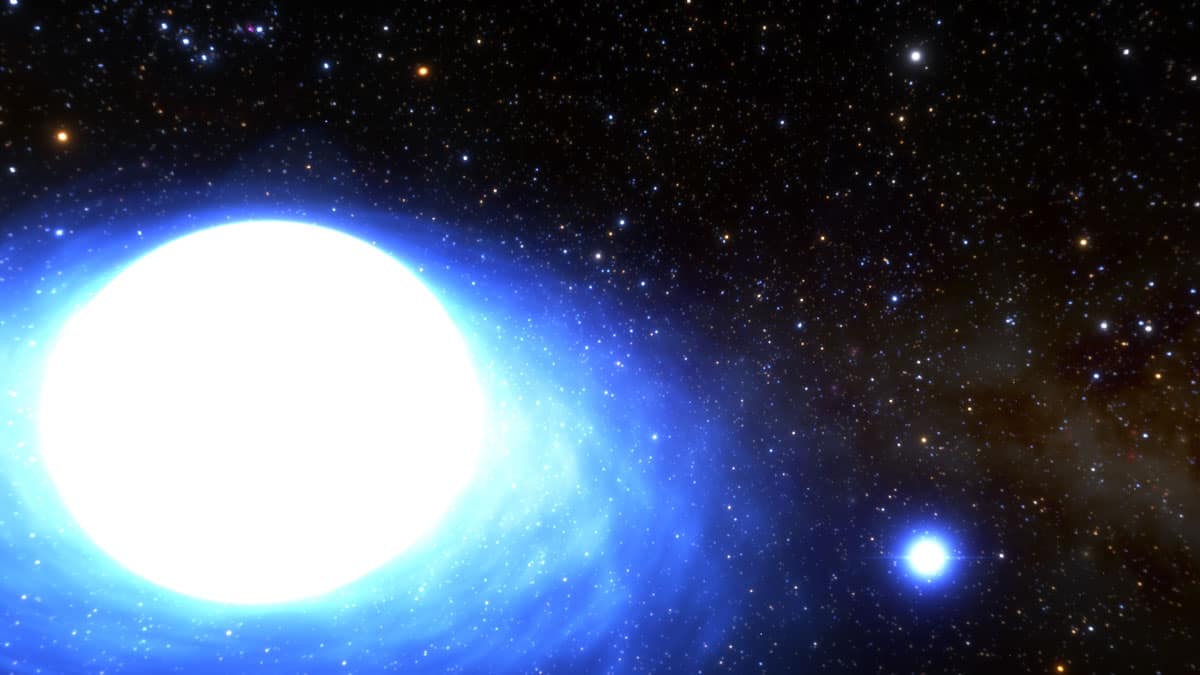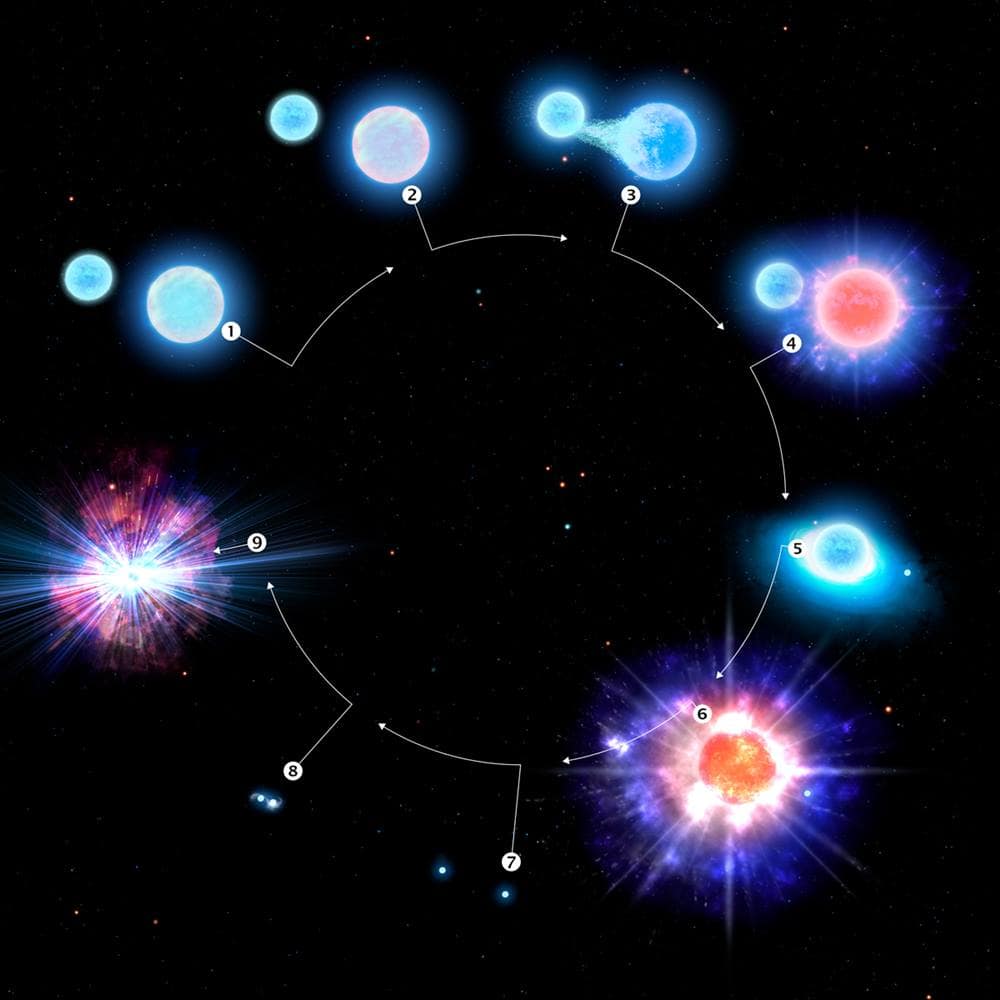| Feb 01, 2023 |
First Kilonova Progenitor System identified
|
|
(Nanowerk News) Astronomers using the SMARTS 1.5-meter Telescope at Cerro Tololo Inter-American Observatory in Chile, a Program of NSF's NOIRLab, have uncovered the first example of a phenomenally rare type of binary star system, one that has all the right conditions to eventually trigger a kilonova — the ultra-powerful, gold-producing explosion created by colliding neutron stars. Such an arrangement is so vanishingly rare that only about 10 such systems are thought to exist in the entire Milky Way Galaxy.
|
|
The findings are published in the journal Nature ("A high-mass X-ray binary descended from an ultra-stripped supernova").
|
 |
| By studying the binary star system CPD-29 2176, researchers are unraveling new clues to our earliest beginnings as stardust. Scientists estimate that there are probably only about 10 such star systems in the galaxy at present. (Photo: NOIRLab / NSF / AURA / J. da Silva / SpaceEngine)
|
|
This unusual system, known as CPD-29 2176, is located about 11,400 light-years from Earth. It was first identified by NASA’s Neil Gehrels Swift Observatory. Later observations with the SMARTS 1.5-meter Telescope allowed astronomers to deduce the orbital characteristics and types of stars that make up this system — a neutron star created by an ultra-stripped supernova and a closely orbiting massive star that is in the process of becoming an ultra-stripped supernova itself.
|
|
An ultra-stripped supernova is the end-of-life explosion of a massive star that has had much of its outer atmosphere stripped away by a companion star. This class of supernova lacks the explosive force of a traditional supernova, which would otherwise “kick” a nearby companion star out of the system.
|
|
“The current neutron star would have to form without ejecting its companion from the system. An ultra-stripped supernova is the best explanation for why these companion stars are in such a tight orbit,” said Noel D. Richardson at Embry-Riddle Aeronautical University and lead author of the paper. “To one day create a kilonova, the other star would also need to explode as an ultra-stripped supernova so the two neutron stars could eventually collide and merge.”
|
|
As well as representing the discovery of an incredibly rare cosmic oddity, finding and studying kilonova progenitor systems such as this can help astronomers unravel the mystery of how kilonovae form, shedding light on the origin of the heaviest elements in the Universe.
|
|
“For quite some time, astronomers speculated about the exact conditions that could eventually lead to a kilonova,” said NOIRLab astronomer and co-author André-Nicolas Chené. “These new results demonstrate that, in at least some cases, two sibling neutron stars can merge when one of them was created without a classical supernova explosion.”
|
|
Producing such an unusual system, however, is a long and unlikely process. “We know that the Milky Way contains at least 100 billion stars and likely hundreds of billions more. This remarkable binary system is essentially a one-in-ten-billion system,” said Chené. “Prior to our study, the estimate was that only one or two such systems should exist in a spiral galaxy like the Milky Way.”
|
 |
| This infographic illustrates the evolution of the star system CPD-29 2176, the first confirmed kilonova progenitor. Stage 1, two massive blue stars form in a binary star system. Stage 2, the larger of the two stars nears the end of its life. Stage 3, the smaller of the two stars siphons off material from its larger, more mature companion, stripping it of much of its outer atmosphere. Stage 4, the larger star forms an ultra-stripped supernova, the end-of-life explosion of a star with less of a “kick” than a more normal supernova. Stage 5, as currently observed by astronomers, the resulting neutron star from the earlier supernova begins to siphon off material from its companion, turning the tables on the binary pair. Stage 7, with the loss of much of its outer atmosphere, the companion star also undergoes an ultra-stripped supernova. This stage will happen in about one million years. Stage 7, a pair of neutron stars in close mutual orbit now remain where once there were two massive stars. Stage 8, the two neutron stars spiral into toward each other, giving up their orbital energy as faint gravitational radiation. Stage 9, the final stage of this system as both neutron stars collide, producing a powerful kilonova, the cosmic factory of heavy elements in our Universe. (Image: CTIO / NOIRLab / NSF / AURA / P. Marenfeld) (click on image to enlarge)
|
|
Though this system has all the right stuff to eventually form a kilonova, it will be up to future astronomers to study that event. It will take at least one million years for the massive star to end its life as a titanic supernova explosion and leave behind a second neutron star. This new stellar remnant and the pre-existing neutron star will then need to gradually draw together in a cosmic ballet, slowly losing their orbital energy as gravitational radiation.
|
|
When they eventually merge, the resulting kilonova explosion will produce much more powerful gravitational waves and leave behind in its wake a large amount of heavy elements, including silver and gold.
|
|
“This system reveals that some neutron stars are formed with only a small supernova kick,” concluded Richardson. “As we understand the growing population of systems like CPD-29 2176 we will gain insight into how calm some stellar deaths may be and if these stars can die without traditional supernovae.”
|


